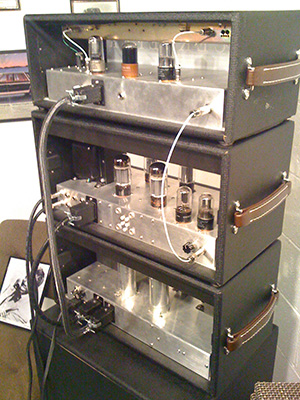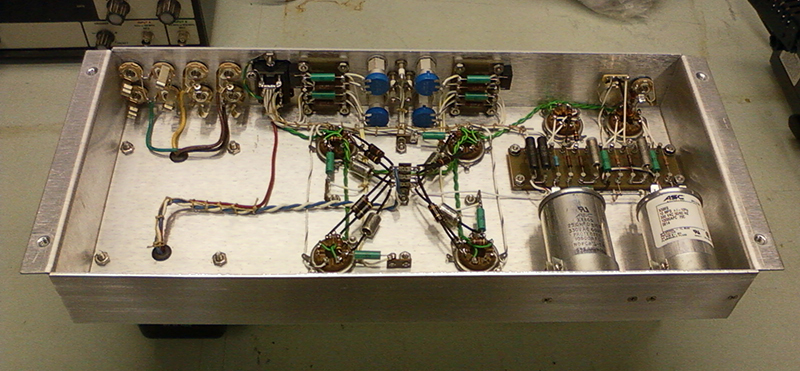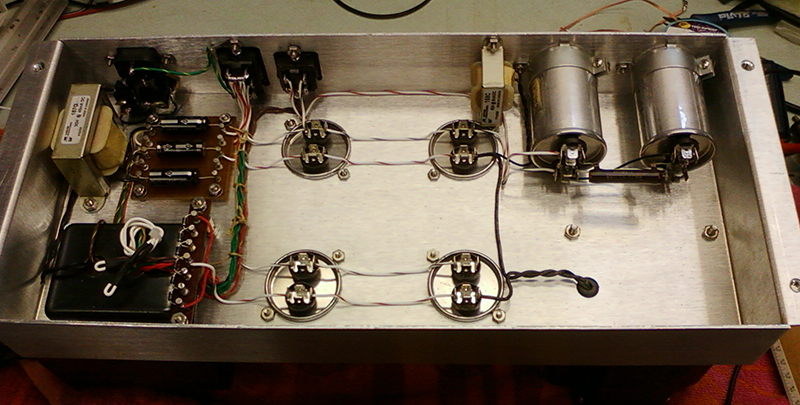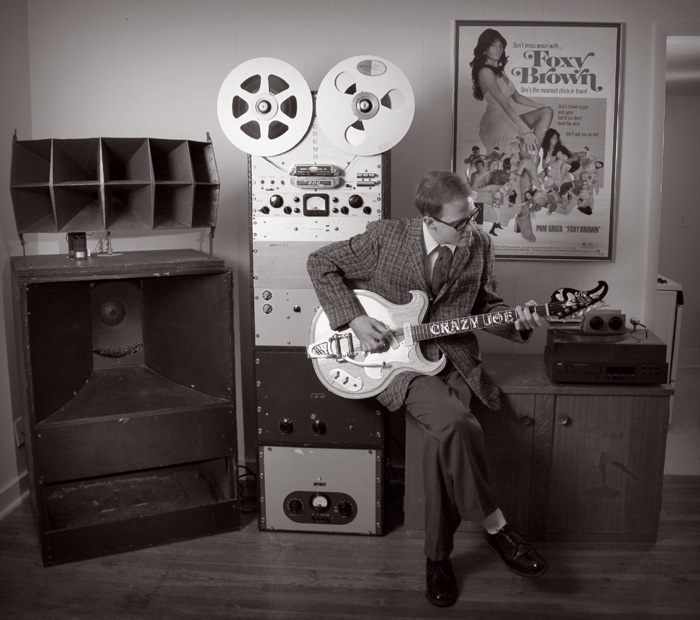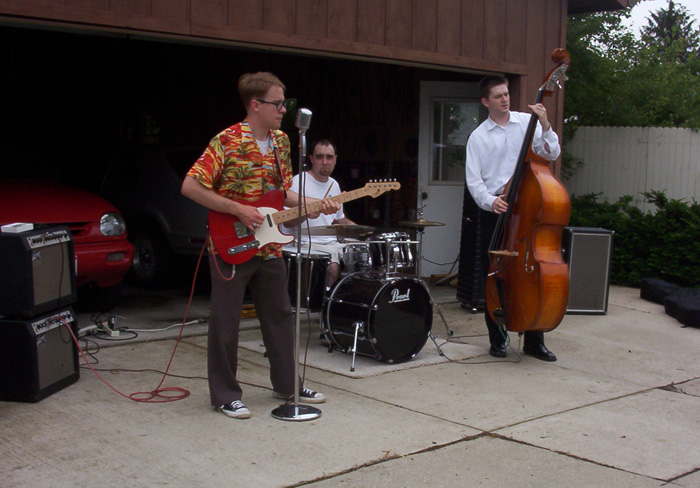|
||||
Guitars, Etc. |
||||
|---|---|---|---|---|
This page is for guitar nerds who want to know all the nerdy details of the musical equipment I play live and in the studio. I certainly don't mean "guitar nerds" as an insult, because after all, it takes one to know one! It’s
no secret that I’m an incorrigible tinkerer, constantly
tweaking my instruments and amplifiers to get the sound I’m
looking for; and, for better or worse, I’ve been that way
since I was a kid. In third grade, frustrated by my parents’
refusal to buy me an electric guitar, I shoved a microphone down the soundhole of my kid-sized Harmony acoustic
guitar and cranked it up all the way through the amplifier and speakers of a Califone reel-to-reel; voilá, problem solved (and
a new one created for my poor folks). That basically set the precedent for the next 30+ years. |
||||
I play Simmons guitars; they're all I own now. Each one was handmade by my buddy Casey Simmons, whose day job is restoring vintage airplanes at the National Museum of the United States Air Force in Dayton, Ohio. I've championed various other instruments over the years such as the Ovation Breadwinner, G&L ASAT, and the low-impedance Gibson Les Paul Recording; but Casey's guitars are truly great and I am incredibly fortunate to call him a good friend. As for amplifiers...scroll down and it's a whole 'nother story. So folks, by popular demand, here's a rundown of my crazy guitars. |
Now THAT's a guitar face! Mad River Outlaws' Spain tour, March 2009 Image ©2009 Marta Pri |
|||
The "Crazy Joe" Guitar; |
||||
The guitar I am most identified with is the Simmons "Crazy Joe" Trifonic, my main instrument since July 2005. What’s so special about this guitar? Well, its most important feature by far is that it says “CRAZY JOE!” on the neck in mother-of-pearl! All kidding aside, Casey and I really put a lot of thought into every detail of this guitar’s design and construction, which began in late 2004. I told Casey I wanted a big, heavy, fancy, Cadillac of a guitar with my name on the fretboard and a body shape I sketched out during a particularly boring Ph.D. seminar class. Casey had his own ideas about what types of construction would be the sturdiest and have the best tone. The end result is a guitar that is truly unique. |
||||
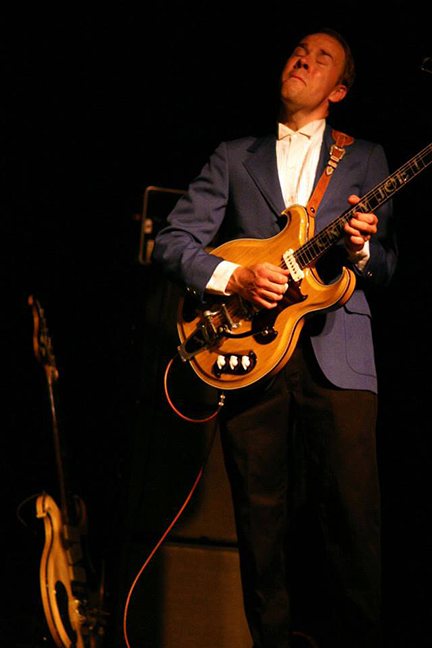 Actor's Theater, Fairborn, Ohio, June 2013. Peacekeeper Mk. II can be seen in the background. Image ©2013 Kristin Kay |
In the initial planning stages, Casey and I talked a lot about construction styles and how they affect the guitar's tonal response. At the time, he was quite taken by the high-end Rickenbacker 381, and its influence on the design of the Trifonic is unmistakable; just witness the German carve and zero neck angle. Less obvious is the neck-to-body joint which, like the 381, has a neck tenon that extends much further into the body than most set-neck guitars. In our case, it goes all the way to the end, making it a hybrid between set-neck and neck-through-the-body designs. It's a very strong joint and a very efficient mode of vibration transfer. For tonewoods, we chose African black limba for the neck and white limba (also known as Korina) for the body. These woods are not particularly dense, but when used in a solidbody guitar 1-3/4” deep and 16” wide like a hollowbody, the result is not exactly a lightweight; the guitar weighs close to 13 pounds! All that mass really contributes to the guitar's clean, sustaining, even tone. The neck is very large - I asked Casey to make the biggest neck he could get out of the piece of lumber - and has a pronounced “V” shape. I'm told it resembles a 1920's Gibson L-5 neck. The 12"-radius fingerboard and headstock overlay are ebony. |
|||
The electronics, as you'd expect, represent lots of experimental tweaking. I chose three G&L ASAT "MFD" pickups for their very clean, wide-bandwidth "hi-fi" sound; and because I used them for many years in my various G&L guitars. The MFD design uses a single ferrite bar magnet underneath the coil and large threaded steel polepiece inserts that, according to Lindy Fralin, results in an efficient magnetic field geometry somewhere between alnico slugs and steel polepiece screws. The neck pickup is stock, the reverse-angled middle pickup is a stock ASAT bridge pickup, and the bridge pickup is an ASAT neck pickup modified by Lindy for a louder, more robust sound. Rather than simply re-wind the pickup with thinner wire, Lindy reglued the flatwork further down the polepieces, effectively lengthening the bobbin for a more efficient coil geometry and allowing more turns. The result is a punchy, clear-sounding bridge pickup with the solidarity of a steel guitar; exactly what I was looking for. And of course, I used Clarostat conductive-plastic sealed pots, a gold-flashed silver-contact ceramic wafer switch, and Teflon-insulated, silver-plated aircraft wire. Does all that mil-spec hardware make a better-sounding guitar? Probably not, but it sure is reliable. |
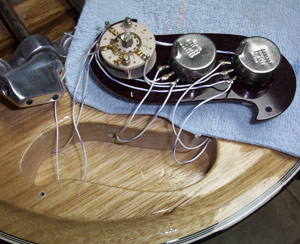 At my kitchen table in Enon, Ohio, January 2008. The Merle Travis Bigsby assembly didn't last long - I hated that thing. Image ©2008 Joe Tritschler |
|||
.jpg) Close-up of the Mastery bridge and Fralin-modified bridge pickup. Image ©2011 Casey Simmons |
The Bigsby vibrato tailpiece is a B7 model with tension bar, which was necessary because of the guitar's zero neck angle. The guitar’s bridge was originally a “badass”-style
wraparound tailpiece anchored to the body with locking studs, followed by a homebrew roller bridge that Casey machined out of aircraft aluminum. I'm now using the Mastery Bridge and I think it's the greatest thing since sliced bread for tone, tuning stability, and ergonomics - not to mention the strings no longer pop out of the saddles! I can't recommend it enough. Tuners are Sperzel TrimLoks, proudly made in Cleveland, Ohio. |
|||
The guitar has all kinds of cosmetic goodies, like a German carve to the front and back of the body, real nitrocellulose finish and tortoise-grained cellulose nitrate bindings and, best of all…nut and “horn-protectors” made of fossilized wooly mammoth bones! The pickguard and armrest were originally polished aluminum, but these were replaced with .125” solid cellulose nitrate tortoise in 2006. The medium-sized frets were dressed extra low at my request by Casey. The guitar has travelled the world and been remarkably reliable; it once held perfect tuning for three weeks straight on tour with Deke Dickerson. |
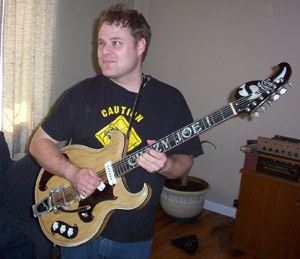 My good ol' buddy Ryan Bussey. Most of my old G&L's passed through his hands... sometimes more than once! I believe he helped shovel my driveway that day in March 2008. Image ©2008 Joe Tritschler |
|||
So how did I meet Casey Simmons? In the summer of 1999, when I was an electrical engineering undergraduate student at Wright State University, I had put a Hammond M-3 organ up for sale in the local Tradin’ Post (remember the days before eBay and craigslist?). He and a friend came and bought it, we exchanged numbers and jammed a few times together. He was only a year out of high school at the time. We hadn't spoken for a few years when he called me up in early 2004 asking for help wiring a guitar he’d built in his parents' basement; I said sure, come on over. What he brought over was stunning. I kept asking him again and again, “you built this?” The binding, fretboard and headstock inlays, finish work, fret detailing…all were just amazing, and the guitar played like butter and sounded fantastic. I asked him if he’d consider building me a guitar and he said this one was only his second, but he’d certainly try. We started hashing out the Trifonic immediately thereafter. I later bought both of his first two guitars. |
||||
The Simmons Mark-II |
||||
| This is the second guitar Casey ever made, the one that impressed me so much I asked him to build the Crazy Joe guitar. Chambered purpleheart body with AAAAA flamed maple top; three-piece purpleheart/maple neck with a flamed-maple headstock overlay; and ebony fingerboard with Super-400-style inlays. I asked Casey to install the Mastery Bridge, Mastery Vibrato, Sperzel Sound-Lok tuners, and 16%-underwound Fralin P-90's with alnico rods in the neck position. I used it on almost every track on The Doctor Is IN! and have taken it all over the world. Both of Casey's first two guitars were clearly inspired by Brian May's Red Special, but also slightly influenced by the little-known Gibson Les Paul Signature model of the 1970's. What an outstanding instrument. | ||||
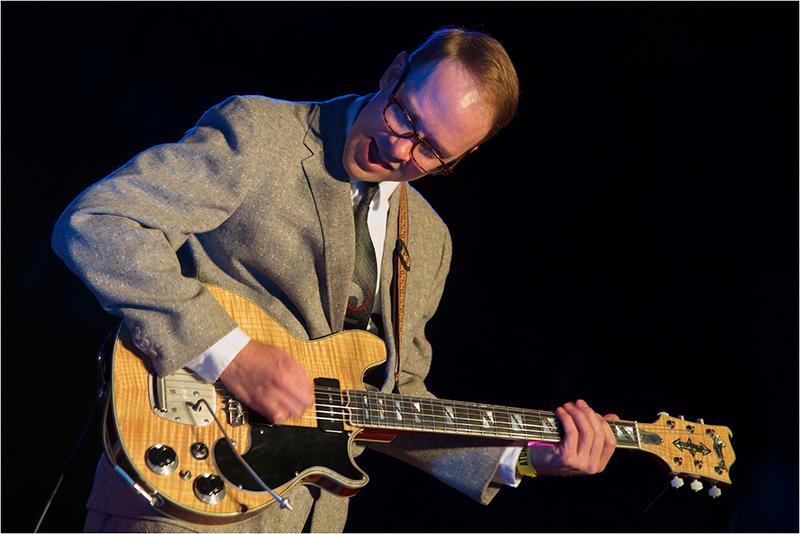 With the Simmons Mark-II at the 2015 Atomic Festival, Sywell Aerodrome, Northamptonshire, UK. Mark Gilbert won first prize in the Bristol Photographic Society's Projected Image Competition with this photo, entitled "It's Crazy Again!" ©2015 Mark Gilbert |
||||
Simmons Trifonic #2 |
 Actor's Theater, Fairborn, Ohio, June 2013. Image ©2013 Kristin Kay |
|||
| When Casey built the Crazy Joe guitar, he built an almost identical guitar for himself at the same time. Of course, it doesn't say "CRAZY JOE!" on the fretboard; it has block inlays like a Les Paul Custom and a 24-3/4" scale length instead of 25-1/2". It also has Fralin Hum-Cancelling Jazzmaster pickups instead of G&L MFD's. Except for one gig in January 2006 with a short-lived band called the Mad River Combo, Casey never actually played the guitar - must've decided it was too big, heavy, and weird. So I bought it from him in early 2012. It's got a slightly smaller neck, slightly bigger frets, and it's a little lighter than the Crazy Joe guitar; in other words, a kinder, gentler version that is really special and has a uniquely rich, clear tone. Beautiful. | ||||
The Electric Ukulele |
||||
Ah yes, the electric ukulele. I conceived this twisted idea in 1992 and built it in eighth-grade shop class after school. Actually, my teacher Mr. (Rich) Allen did most of the work on the two-piece walnut body, and its workmanship is perfect. I made the original neck, which was curly maple with four strings no truss rod, and it was a true piece of crap with terrible fretwork that warped immediately. Casey Simmons made me a new six-string octave-up neck out of Honduran mahogany with a Bois de Rose fingerboard in late 2005 so I could pretend like I’m Joe Maphis (yeah, right) and installed G&L ASAT MFD pickups like my Trifonic. The scale length of this instrument is quite a bit longer than it should be for an octave-up guitar. The good thing is that it keeps the frets from being too close together, but as a result the strings are at ridiculously high tension, even with .009’s, and the high-E string will break on tune-up if you don’t take it really easy - I broke three trying to record a 30-second part on the “Electric Ukulele Rag” from the Sweatin’ Bullets Over You EP. In fact, I tuned it down a step-and-a-half for “Remington Rock” on The King of Nerd-A-Billy. But the tone of this instrument is really special; perhaps because of the ultra-high tension and super hi-fi pickups, it eerily resembles the sped-up Les Paul/Mary Ford guitar sound. I used it all over the place on The Doctor Is IN! album. Someday, I plan to make a truly evil instrumental album using it...stay tuned! |
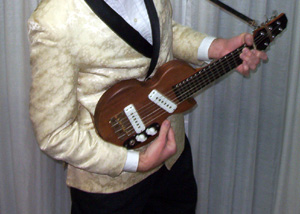 In my kitchen, November 2009; smoking jacket courtesy of Dawn Cooksey. Image ©2009 Stephanie Layne |
|||
|
||||
| Guitar amplifier technology is where my nerdiness really shows. The first thing I ever tried to build from scratch, circa-7th grade, was supposed to be a tube distortion device so I could get some overdrive on my clean-as-a-whistle Kustom 150 amp. This time, my parents refused to buy me a distortion pedal; oh, the horrible injustice of being denied an Arion Metal Master from the Guitar Guys in Heath, Ohio. I made this death trap out of an old tube AM radio and did eventually get the thing to work after all the soldering iron burns and shocking the crap out of myself a few times…but it didn’t exactly sound like a wall of Marshalls. This progressed to reverb units, fuzz pedals, and modifying old amps, and by the end of high school I could build a halfway decent amplifier that didn't blow up during pep band. I've kept it nerdy ever since. | ||||
The Peacekeeper |
||||
I call my main amp the "Peacekeeper," tastefully named after the ten-warhead ICBM of the 1980's. It's really not super powerful or insanely loud, but it's the closest I've come to a pure, unrestricted engineering effort and it's all I use now. What's different about the amp? For starters, the power supply, amplifier, and preamplifier are on separate chasses with military-style Jones-plug umbilical cables connecting them together.
Why did I make it this way? One reason is because the amplifier uses the least-efficient mode of operation possible; Class A1 parallel-single-ended triode connection, for you amp nerds. By contrast, most guitar amplifiers use push-pull pentode operation, which is 3-4 times more efficient for a given size and cost. Basically, I've got four 6CA7 output tubes and a 200W-sized power supply and output transformer just to get 30 watts output. Building the whole thing on one chassis would probably have resulted in someone's death or a major hernia operation. Each piece is actually very manageable weight-wise. Separating the sections also makes for an extremely quiet amplifier. Why such a weird approach? Well, I've been using triode connection in guitar amps since 2001, but this is the most luscious-sounding amp I've made yet. I have to thank my uncle Joe Mahalka and Dr. Brad Dean for encouraging me to go single-ended. I'll likely never go back. |
 The Peacekeeper with amp and power supply grilles removed, Simmons Mk-II guitar, and two of my bass reflex speaker enclosures with JBL G125-8's. Photo © 2013 Chris Bell. |
|||
| I wired the circuitry point-to-point on mil-spec silver turret boards and tried to use the very best components I could in the construction of this thing: silver/Teflon aircraft wire; Allen-Bradley carbon composition, mil-spec Dale RN-series metal film, and precision Tepro wirewound resistors; Sprague 196P Vitamin-Q and Gudeman XHF paper-in-oil signal capacitors; Bourns and Allen-Bradley Type-J pots; and NOS Cinch octal sockets with full-wraparound contacts. The preamp and drive stages use all octal preamp tubes; 6SL7's and 6BL7's, with a 6SJ7 pentode in the special reverb-drive circuit. I even used ASC X386S polypropylene oil caps in the B+ power supply so I'd theoretically never have to change them like ordinary electrolytics. I also feel that they sound better. To that end, I used big film caps for cathode bypass rather than 'lytics, too. Chasses came from Watts Tube Audio and they're very high-quality. |
||||
|
||||
| The cabinets are all simple butt-jointed Baltic birch, but I put a lot of thought into the design of the matching speaker enclosures, of which I eventually built a total of five; two for the studio and three for live shows. They're essentially 2-cubic-foot bass reflex (ported) cabinets, lined with fiberglass and very accurately tuned to 80 Hz. I think this setup gives the cleanest bass response and I doubt I'll ever go back to open-back or infinite-baffle guitar cabinets. I'm using half-inch-thick "Mitchell donuts" in front of the speakers, and they really do work! The two cabinets I normally use for recording have JBL G125-8 speakers in them. | 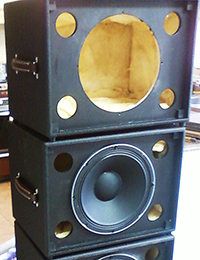 Speaker enclosures with grilles removed, showing bass reflex tuning. These speakers are Electro-Voice EVM12L's, which I use live. Photos © 2011 Joe Tritschler |
|||
| So how does this system sound? Buy my new album and find out! | ||||
Peacekeeper Mk. II |
||||
| A variation on the "Peacekeeper" theme is a pair of all-in-one amplifier heads, designed and laid out by me with chassis fabrication by Casey Simmons. Casey liked the idea of the Peacekeeper amplifier but didn't want to build an exact copy of it (I wonder why?); he asked if I could design a simplified amp head without reverb and a more reasonable power supply, around which he'd make a powdercoated aircraft aluminum chassis and cabinet. I said sure, as long as in exchange for my design work he'd make two of 'em! We call these two 25-watt amps the "Peacekeeper Mark-II" and they have the same basic driver and output stage as the Peacekeeper. I won't lie, it weighs a ton, but it sounds great and gets used a lot, both live and in the studio. | ||||
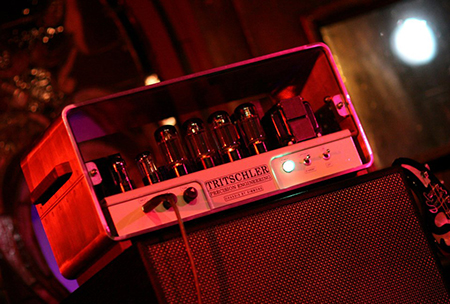 Peacekeeper Mk. II in action at Dayton's Canal Street Tavern! Just volume and tone controls - what else is there? Dig the Makrolon polycarbonate front, allegedly bullet-proof. Image ©2013 Kristin Kay |
||||
.jpg) Underside of the Mark-III Peacekeeper. Mil-spec pots and resistors, Sprague Vitamin Q caps, choke-filtered bias supply...come on, what did you expect? Image ©2012 Joe Tritschler |
||||
Old Stuff |
||||
| Here are some photos of equipment I no longer own, but of which I have fond memories. | ||||
| Exhibit A: Here's an amp rig I used for many, many years. It's a very rare (and totally irreversibly modified) 1973 WEST Avalon Reverb amplifier and a cascade-sparkle late-60's Kustom 2x15 cab, both of which I'd had since I was a teenager; bought the cab empty from the Guitar Guys when I was a freshman in high school, got the amp as a basket case from the legendary Chris Ivan when I was 19, and traded Deke Dickerson for the OEM Kustom-branded JBL D130F-6's in 2004. WEST amps were hand-made in Michigan using Dynaco transformers and very rugged turret-board construction, and this model was originally an exact copy of a Fender amp. Someone had already mangled the chassis on this one, so I didn't feel bad modifying it to death. It wound up with triode-connected push-pull class-A1 Mullard EL-34's and a transformerless reverb circuit with anode-follower summing and special EQ. I briefly added a gold Kustom PA head cabinet into which I stuffed a JBL 2370 horn and 2425J driver with a unique crossover/EQ circuit that attempted to sound like a guitar speaker but without the beaminess at high frequencies. |  Onstage with Nicky Kay and his Fabulous Kaytones! Peach's Grill, Yellow Springs, Ohio, July 2005. This was the first gig I ever played with my shiny, new Crazy Joe guitar! Image ©2005 Cathy Simmons |
|||
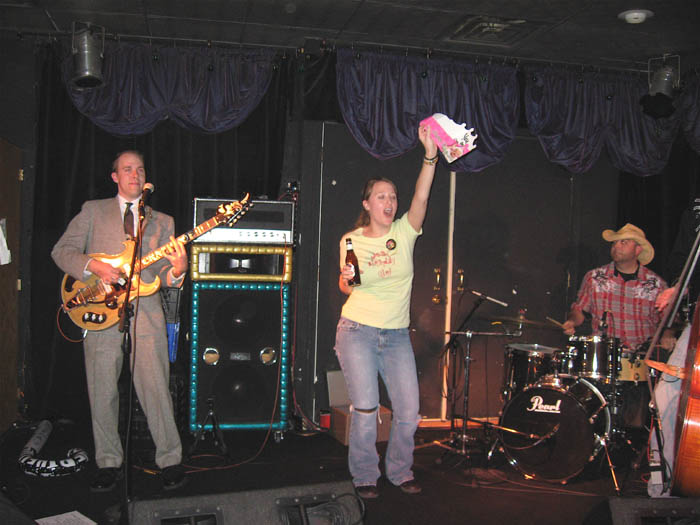 That's my sister, "Crazy Betsy," on her 30th birthday in November 2010, alongside the illustrious "Punkin'" Pat Lee on drums. She requested a reunion of the original Mad River Outlaws for her birthday and she got it! Our parents must be very proud. Image ©2010 Laura Rigsbee |
||||
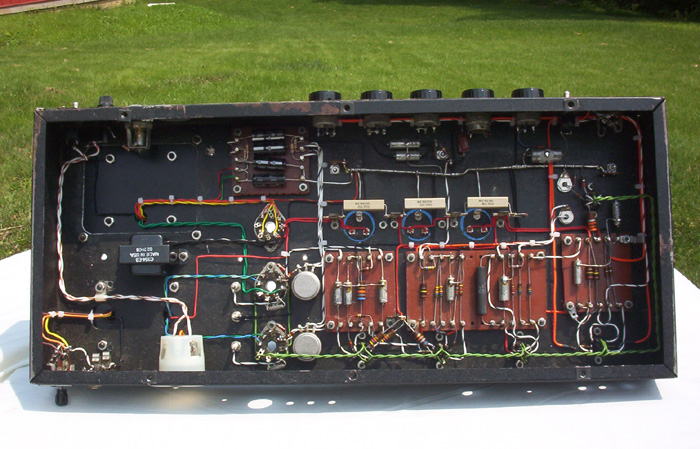 True nerds may appreciate this photo, taken in my back yard a few years ago after I installed the "DynaClone" MK-IV transformers, Allen-Bradley carbon comp resistors, Sprague 196P Vitamin-Q oil caps, silver/Teflon wire, sealed A-B bias pots. Not shown are the original Mullard EL-34's I've had in the amp since 1998 and are still going strong, despite dissipating close to 30W each continuously. Image ©2008 Joe Tritschler |
||||
| The WEST amp was described in the 2008 Guitar Player interview (original text appears HERE) and I used it from the very beginning of the Mad River Outlaws until April 2011, when this rig was replaced by the Peacekeeper. The WEST/Kustom rig represented over a decade of continual refinements and its circuitry is much different than any of the "classic" guitar amps. I'm proud to say that it's now being used by my old buddy Eric Sargent on tour with ekoostik hookah! He elected not to use the horn, though...what a wuss. | 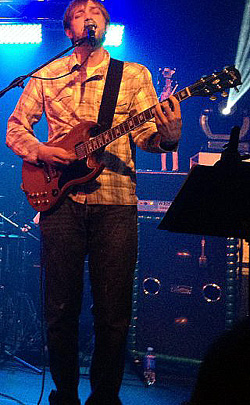 My high school pal Eric Sargent on tour with ekoostik hookah! Image ©2012 Jim Garibaldi |
|||
| Exhibit B: The Rig of Death. Described in the GP article interview, this was my vision of a truly insane guitar amplifier...Altec A-5 Voice of the Theater horn speaker, biamplified Presto disc cutter amps, Fisher SpaceXpander reverb, and tube Crown tape echo deck with 14" Muzak reels! The speaker allegedly came out of a theater on the west side of Dayton and was full of cigar butts when I got it. The Presto amps came out of Coronet Recording Co., a classic old recording studio in Columbus, and the tape deck came from master Crown technician John Haines in Goshen, Indiana. This setup also doubled as my living room hi-fi in the Yellow Springs apartment where I recorded the King of Nerd-A-Billy, if you can believe that. Earlier versions of the Rig of Death included an Ampex 400 transport with 350 and 351 electronics plus an Ampex MX-35 mixer, one of these setups being used to open up for the Reverend Horton Heat at Canal Street Tavern in 2003. The system has long since been parted out. | ||||
|
||||
| Exhibit C: For a brief period around 2002-2004, I used two stacked mid-60's Gibson Minuteman amplifiers with JBL G125-8 speakers in them (and, for a while, mint-condition original-cone JBL D120F's). The amps were fairly stock; I replaced the front-end 6EU7 tubes with 12AT7's (actually GE five-star 6201's), which required a socket re-wire, and removed the awful midrange-dip filters found in many Gibsons from that period. They actually sounded pretty great with cathode-biased EL84's and an interstage transformer, and they easily fit on the back seat of my 1971 Cadillac - very important. In the end I sold 'em and went back to big triode amps and ported speaker cabinets because I just couldn't get a good clean low-end out of open-back amps, but they did have that really nice slightly-crunchy sound you can hear on the Chopped, Slammed, & Twangin' album. The guitar is my once-beloved 1993 G&L ASAT Classic with '97 George Fullerton V-neck and three-barrel Tele bridge. Great guitar with a resonant three-piece lightweight ash body. | ||||
|
||||
| Exhibit D: No comment. | ||||
 Tyrd Fyrgysyn playing one of the many, many Ovation Breadwinners I had accumulated since I got my very first one right after I turned 13. This is a rare "Buckskin" finish model, affectionately named "Flesh Gordon" by Michelle Oleck at the fondly-remembered Ed's Guitars in Miami. I traded a highly-modified 1963 Gibson SG Junior for this guitar in the late-90's, if you can believe that. Photo taken at Canal Street Tavern in Dayton, Ohio, possibly by Juliet Fromholt. Photo date unknown, probably circa 2006-2007. |
||||
© 2016 Tritschler Precision Engineering, LLC. All Rights Reserved. |
||||

